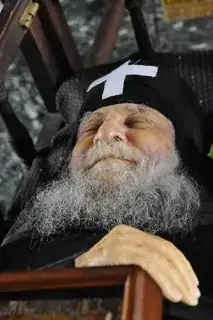Elder Joseph of Vatopaidi was the Abbot of The Holy and Great Monastery of Vatopedi on Mount Athos, Greece. He died in 2009.
Several religious Christians claim that his corpse started to smile after his death, and claim this as a miracle.
-
A Simple Biomedical Presentation of the First Miracle of Elder Joseph of Vatopaidi Who Smiled 45 Minutes After His Death
-
In the case of Elder Joseph, upon death we know that his muscles relaxed and his mouth opened and he died in that position. Interestingly rigamortis set in quickly while his mouth was open. We know the monks tried to close his mouth for the funeral service but could not. Also, when rigamortis sets in, you cannot tie anything around the mouth to close it either; it must be tied while the muscles are still relaxed and releasing the oxygen. Postmortem movements where rigamortis sets in are impossible also. The amazing fact in all this is that the smile occurred 45 minutes after death while in a state of rigamortis. Also, mouths, like eyes, do not close on their own once opened after death though they can do the opposite.
-
Thus, they came back to the cell, to prepare the reposed according to the monastic. Elder Ephraim ordered them to leave his face uncovered. The fathers tried to close his mouth, but as it was quite late, his mouth remained open. They even tied a gauze around his head, so that his mouth would remain closed, but after they removed it his mouth opened up again. About 45 minutes had already gone, by since he had passed away.
Did the corpse of Joseph of Vatopedi start smiling after his death?
